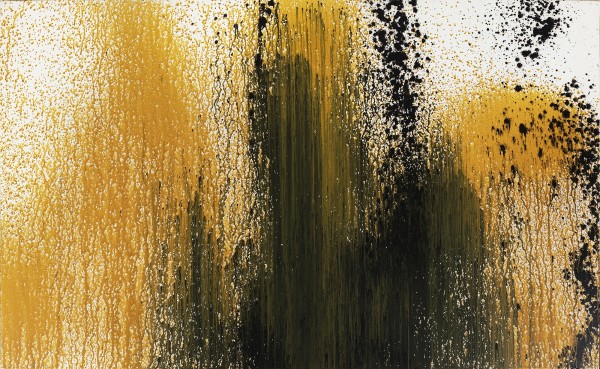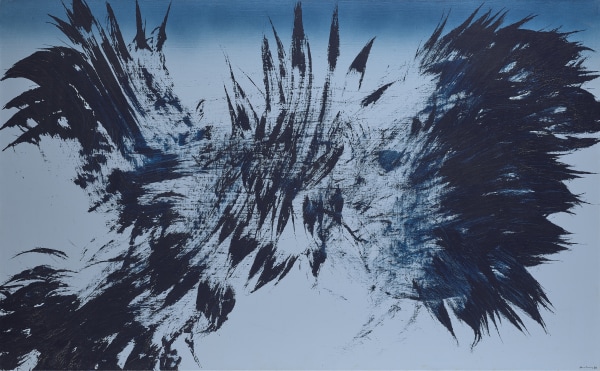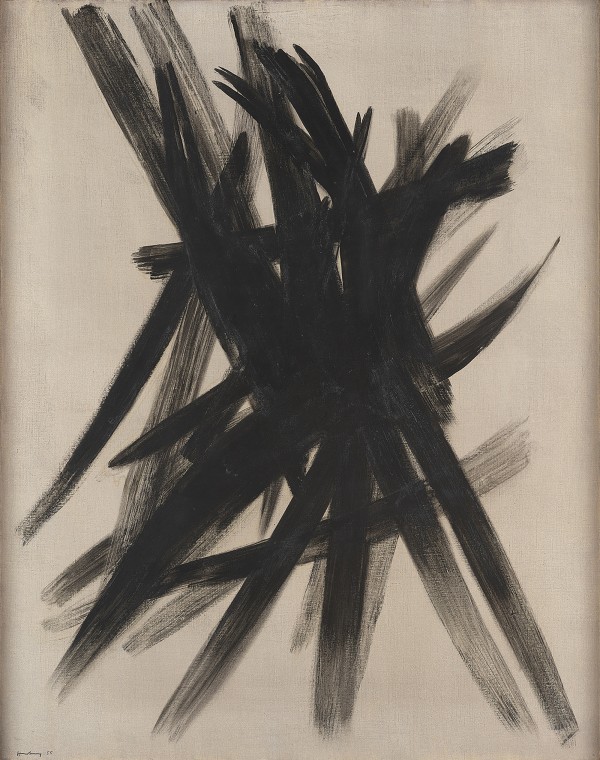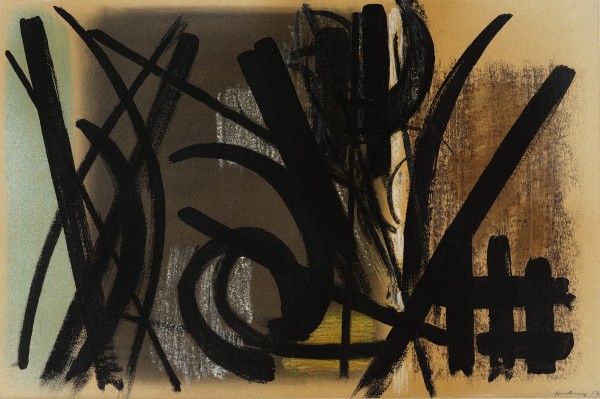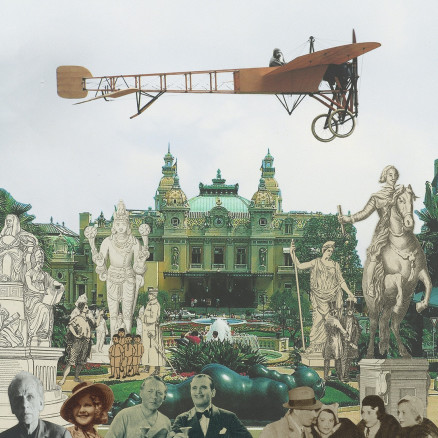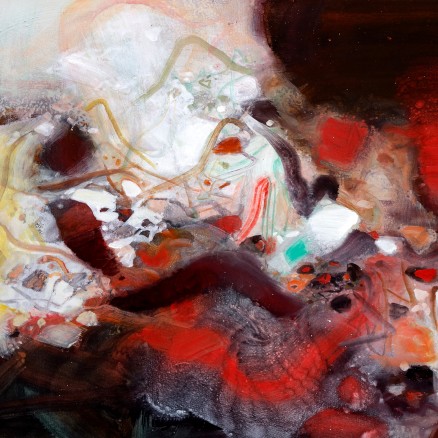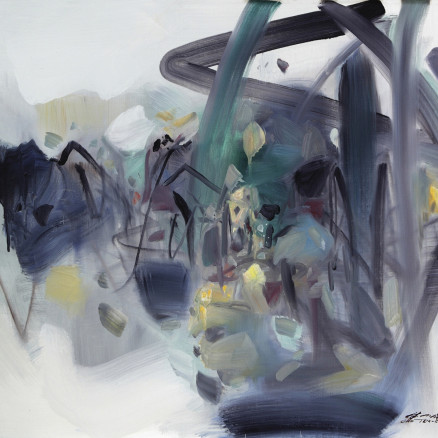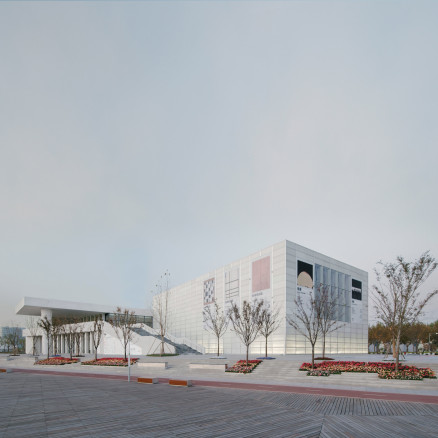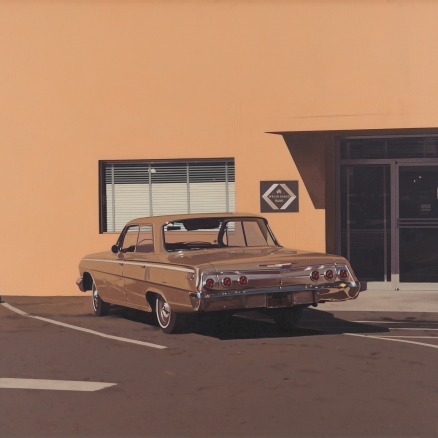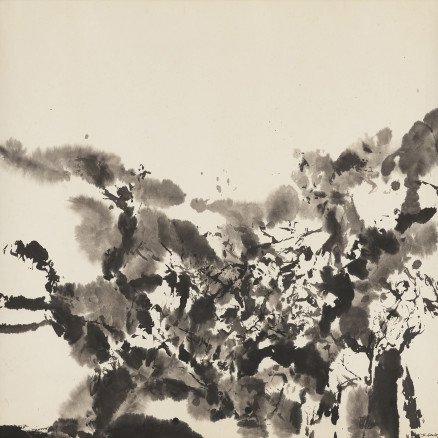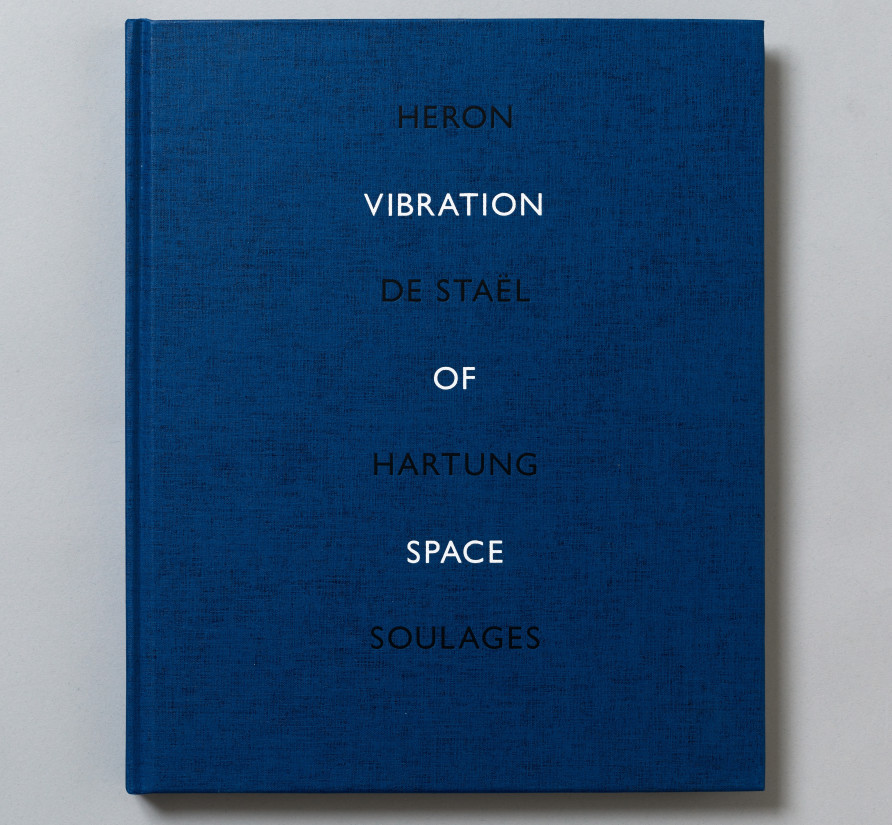Biography
Hans Hartung (b.1904, Leipzig, Germany; d.1989, Antibes, France) is celebrated for his dynamic and experimental contribution to 20th century abstraction. His carefully composed early works, characterised by linear motifs and calligraphic brushstrokes, established Hartung as a leading Tachist artist and proved particularly inspirational to American abstraction in the 1960s and 1970s. From 1960, Hartung’s inventive use of varied painting tools – ranging from metal combs, rakes, wool and knives to foam rollers and air-spray-guns – to scratch, rather than draw, linear marks placed him on a singular trajectory. The groundbreaking large-scale ‘sulfateuse’ canvases that Hartung made in the last years of his life, from 1986–1989, assimilated an increasingly frenzied movement as he sought to capture ‘universal energies’ in the world, and had a profound influence on subsequent generations of abstract artists.
Having studied Graphic Design in Leipzig, in 1925 Hartung enrolled in painting at the Akademie der Künste in Dresden, where in 1931 his paintings were exhibited for the first time at Galerie Heinrich Kühn. In 1929, Hartung married artist Anna-Eva Bergman and in 1932 they built a home in Minorca, which was destroyed in the Spanish Civil War. After a brief return to Germany in 1935 (where Hartung was subjected to police surveillance and interrogation), the couple settled in Paris. There, Hartung became friends with painters Mark Rothko and Pierre Soulages, and sculptor Julio González. In 1938, Hartung participated in the anti-Nazi exhibition, Twentieth-Century German Art, at the New Burlington Galleries in London. The same year, Hartung divorced Bergman and in 1939 married Roberta González, daughter of Juilo. With the outbreak of war imminent, Hartung joined the French Foreign Legion but was invalided out after an attack left him with his right leg amputated. On his return to Paris in 1945, Hartung was granted French citizenship and awarded the Croix de Guerre. Hartung’s first solo show in Paris was held at Galerie Lydia Conti in 1947. In 1950, Hartung and Bergman again crossed paths and resumed their relationship, remarrying in 1957.
The 1950s marked international recognition of Hartung’s work, which was included in the 1951 group show ‘Advancing French Art’ that toured North America. His first museum retrospective was held at Kunsthalle Basel in 1952, followed by an exhibition at the Palais des Beaux-Arts, Brussels in 1954. In 1960, Hartung won the Gran Premio for Painting at the Venice Biennale. The same year, Hartung and Bergman bought an ancient olive grove in Antibes and designed a villa and studios which they moved into in 1973. In 1964, at the invitation of the Carnegie Institute, Hartung made his first trip to the United States. A large-scale retrospective was held at Musée d’Art moderne, Paris, in 1969.In 1981, Städtische Kunsthalle, Dusseldorf and Staatsgalerie Moderner Kunst, Munich organised a major joint retrospective. After a stroke in 1986 left him wheelchair bound, followed by Bergman’s death in 1987, Hartung painted with increasing frenzy. He was made Grand Officer of the Legion of Honour just before his death in 1989. The Fondation Hartung-Bergman was established at Hartung’s Antibes villa in 1994. In 2019, the newly renovated Musée d’Art moderne, Paris was inaugurated with a major Hartung retrospective, ‘La Fabrique du Geste’, which positioned Hartung at the forefront of abstraction and reaffirmed his importance in modern European art.
Read more
Works
-
 Hans Hartung, T1988-K3, 1988
acrylic on canvas
111 x 180 cm
Hans Hartung, T1988-K3, 1988
acrylic on canvas
111 x 180 cm
-
 Hans Hartung, T 1982-H46, 1982
acrylic on canvas
180 x 111 cm
Hans Hartung, T 1982-H46, 1982
acrylic on canvas
180 x 111 cm
-
 Hans Hartung, T1980-E22, 1980
acrylic on canvas
43 3/4 x 70 7/8 in
111 x 180 cm
%3Cdiv%20class%3D%22artist%22%3E%3Cspan%20class%3D%22artist%22%3E%3Cstrong%3EHans%20Hartung%3C/strong%3E%3C/span%3E%3C/div%3E%0D%3Cdiv%20class%3D%22title%22%3E%3Cem%3ET1980-E22%3C/em%3E%2C%201980%3C/div%3E%0D%3Cdiv%20class%3D%22medium%22%3Eacrylic%20on%20canvas%3Cbr%20/%3E%0A%3C/div%3E%0D%3Cdiv%20class%3D%22dimensions%22%3E43%203/4%20x%2070%207/8%20in%3Cbr%20/%3E%0A111%20x%20180%20cm%3C/div%3E
Hans Hartung, T1980-E22, 1980
acrylic on canvas
43 3/4 x 70 7/8 in
111 x 180 cm
%3Cdiv%20class%3D%22artist%22%3E%3Cspan%20class%3D%22artist%22%3E%3Cstrong%3EHans%20Hartung%3C/strong%3E%3C/span%3E%3C/div%3E%0D%3Cdiv%20class%3D%22title%22%3E%3Cem%3ET1980-E22%3C/em%3E%2C%201980%3C/div%3E%0D%3Cdiv%20class%3D%22medium%22%3Eacrylic%20on%20canvas%3Cbr%20/%3E%0A%3C/div%3E%0D%3Cdiv%20class%3D%22dimensions%22%3E43%203/4%20x%2070%207/8%20in%3Cbr%20/%3E%0A111%20x%20180%20cm%3C/div%3E -
 Hans Hartung, T 1955-23a, 1955
oil on canvas
73 x 57 cm
%3Cdiv%20class%3D%22artist%22%3E%3Cspan%20class%3D%22artist%22%3E%3Cstrong%3EHans%20Hartung%3C/strong%3E%3C/span%3E%3C/div%3E%0D%3Cdiv%20class%3D%22title%22%3E%3Cem%3ET%201955-23a%3C/em%3E%2C%201955%3C/div%3E%0D%3Cdiv%20class%3D%22medium%22%3Eoil%20on%20canvas%3C/div%3E%0D%3Cdiv%20class%3D%22dimensions%22%3E73%20x%2057%20cm%3C/div%3E
Hans Hartung, T 1955-23a, 1955
oil on canvas
73 x 57 cm
%3Cdiv%20class%3D%22artist%22%3E%3Cspan%20class%3D%22artist%22%3E%3Cstrong%3EHans%20Hartung%3C/strong%3E%3C/span%3E%3C/div%3E%0D%3Cdiv%20class%3D%22title%22%3E%3Cem%3ET%201955-23a%3C/em%3E%2C%201955%3C/div%3E%0D%3Cdiv%20class%3D%22medium%22%3Eoil%20on%20canvas%3C/div%3E%0D%3Cdiv%20class%3D%22dimensions%22%3E73%20x%2057%20cm%3C/div%3E -
 Hans Hartung, Composition, 1952
mixed media on paper
48.5 x 72 cm
Hans Hartung, Composition, 1952
mixed media on paper
48.5 x 72 cm
-
 Hans Hartung, T1952-45, 1952
oil on canvas
50 x 65 cm
Hans Hartung, T1952-45, 1952
oil on canvas
50 x 65 cm
-
 Hans Hartung, T1947–47, 1947
oil on canvas
97 x 130 cm
Hans Hartung, T1947–47, 1947
oil on canvas
97 x 130 cm






